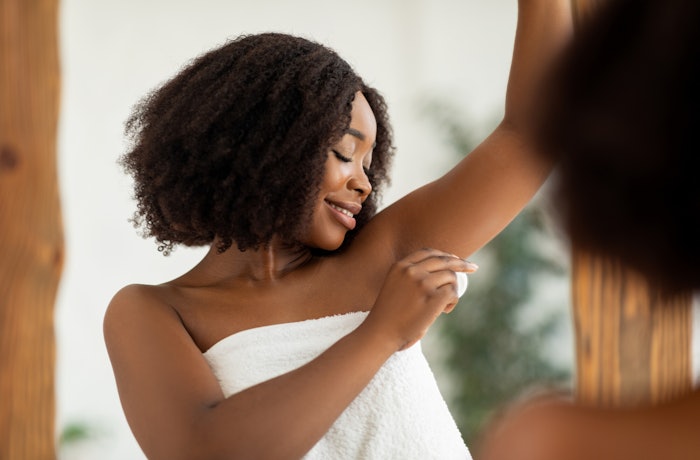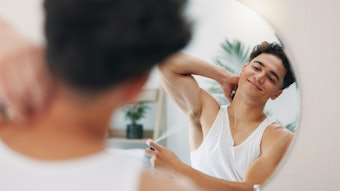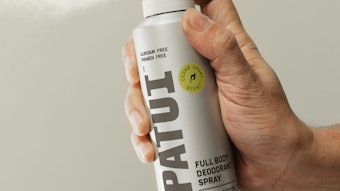
Propanediol caprate combines naturality and performance by targeting odor-causing bacteria while respecting skin microbiome balance. In vitro, ex vivo and in vivo data show odor protection for up to 96 hr and confirm its microbiome-friendly nature.
This article is only available to registered users.
Log In to View the Full Article
Propanediol caprate combines naturality and performance by targeting odor-causing bacteria while respecting skin microbiome balance. In vitro, ex vivo and in vivo data show odor protection for up to 96 hr and confirm its microbiome-friendly nature.
Managing body odor is one of the key cosmetic targets. Causes of body odor range from mental and physical stress, temperature (e.g., hot weather) and hormonal changes, to improper personal hygiene, weight changes, diet, health conditions, genetic background – and of course, sweating.
Human sweat performs two major functions: dissipating heat generated by physical activity, fever or hot environments to prevent heatstroke;1 and serving as a medium for interpersonal communication.2 Both processes are functionally isolated from each other and are spatially separated systems – the eccrine3 and apocrine sweat glands; notably, fresh sweat of either type does not smell.
The apocrine sweat contains complex molecules like sebaceous or apocrine lipids, proteins, various Gln- and Cys-conjugates, and pheromones. These components serve as nutrients for the natural skin microbiota that decompose them,4 leading to the production of metabolites with a particularly low odor threshold – short chain fatty acids like 3-hydroxy-3-methyl-hexanoic acid (HMHA) or 3-methyl-2-hexenoic acid (3M2H), as well as organosulfur compounds like 3-mercapto-3-methyl-1-hexanol and even steroids like androstenol or androstenon.5 Many of these products are volatile, odorous molecules that form body odor.
Beyond biology, there is the more personal dimension of sweating and body odor: feeling embarrassed or ashamed of extensive sweating. Body odor can negatively impact one’s well-being or even mental health.
Historic and Modern Deodorant Actives
Cosmetics target malodor using different approaches, including blocking sweat formation (antiperspirants), masking body odor (fragrances), absorbing or binding odor (adsorbents) and controlling microbes on the skin (deodorant actives). In terms of ingredients, historically, perhaps the most well-known benchmark deodorant is triclosan.
While the regional body spray market in India still heavily relies on triclosan at levels ranging from 0.1% to 0.15% still today, the organochlorine is not frequently used any more in Western markets due to a lack of safety data and potential environmental20 and human health concerns. According to Mintel GNPD, antiperspirant and deodorant products (AP/Deo) that use triclosan have decreased from 621 in 2012 (including 72 in the EU, 306 in APAC, 215 in Latin America, 28 in the Middle East/Africa and 10 in North America) to only 100 in 2024 (7 in the EU, 14 in APAC, 22 in Latin America, 25 in the Middle East/Africa and 0 in North America). Even in India, the number of products launched containing triclosan have decreased from 268 in 2012 to only 9 in 2024, also per Mintel GNPD.
Initially banned from antimicrobial surfactant-based products in the U.S. in 2016,17 triclosan is still positively listed as a "preservative" in the EU, allowed at levels of up to 0.3% in applications including deodorants.18 In Latin America, triclosan is also still permitted up to 0.3% in deodorants; e.g., in Mexico and Colombia, where regulations closely follow rules from the EU cosmetics regulation. In Brazil, however, triclosan is prohibited from spray products, which represent a major share of that AP/Deo market.19
Non-organohalogen actives with antimicrobial properties have also been available for many years (see Table 1). For example, 2-methyl 5-cyclohexylpentanola is used in many modern deodorant formulations8, 9 and it was the first active to be proven ex vivo as microbiome friendly.10
Farnesol is another active with a long history of cosmetic use6, 7 while the more recent nature-derived propanediol caprateb has shown strong efficacy against Gram-positive bacteria. Like farnesol, propanediol caprate demonstrates antifungal effects and its activity against dermatophytes may have relevance for skin protection, particularly in foot odor concepts.
Today’s deodorant consumers demand non-antiperspirant deodorants, low fragrance concepts and products with a high degree of naturalness. In addition, 76% of deodorants launched in 2024 claim to be long-lasting11 – and next to strong performance, respecting the skin's natural microbiome is important to consumers. Deodorant actives like the recently launched propanediol caprate can address these demands.12
As such, the present work tested the odor control efficacy of propanediol caprate in a 96-hr in vivo study. It also examined the ingredient’s impact on the armpit skin microbiome in a 48-hr in vivo analysis, reiterating the importance of microbiome homeostasis next to deodorant efficacy.
In vitro Materials, Methods and Results
Material: Propanediol caprate is a propanediol monoester of C10-fatty acid (capric acid). The biodegradable ester features 100% plant-derived carbon and is produced via a solvent-free catalytic process, adhering to green chemistry principles. The ingredient was developed using a novel 3D ex vivo sweat modelc.13
MIC assay: The antimicrobial profile of propanediol caprate was determined in a Minimum Inhibitory Concentration (MIC) assay. Growth medium was dispensed into well plates, then the respective test substance (i.e., propanediol caprate or control) and test strain were added. The assays were incubated at the optimal growth temperature for the microorganisms tested.
For strains with regular homogeneous growth (i.e., not clumpy), the optical density (OD600) was measured; those that grew clumpy were evaluated visually. The lowest concentration of antimicrobial agent that inhibited the visible growth of microorganisms is regarded as the MIC.
MIC results: The results of MIC testing revealed efficacy against body odor-related Gram-positive bacteria and antifungal effects relevant for foot odor concepts (see Table 2). Notably, propanediol caprate inhibited the anaerobic genus Anaerococcus, which is often difficult to control.12
In addition to the antibacterial effects against Anaerococcus, specifically A. octavius, propanediol caprate showed low MIC values against a broad range of odor-related and cosmetically relevant microorganisms.
In vivo Experimental Designs
Two in vivo studies were conducted comparing armpits treated with propanediol caprate and a placebo control. Olfactory assessments (sniff tests) were performed up to 96 hr after washing. Actives were applied using a volatile aqueous ethanolic carrier system (pump spray). Armpit skin swabs (samples from armpit skin up to 48 hr after application) were subjected to a microbiome analysis to assess the impact on microbial diversity and balance.
Propanediol caprate versus control, 96-hr In vivo study: A randomized, double-blind, half-side test study was conducted in Brazil. Twenty-two subjects with distinct perspiration odor in the armpit area were included. A direct olfactory assessment of odor reduction was evaluated for the test products and control. Subjects underwent a seven-day conditioning period using only unscented soap without antibacterial ingredients. The use of antiperspirants, deodorants or other cosmetics was prohibited. The subjects were instructed to wear only untreated clothing (i.e., no treatment with perfumed detergent or softener). Odor was scored by three trained experts on a scale of 0-10 scale (0 = no odor, 10 = extremely strong bad odor).
After the conditioning period, a controlled washing of the armpits was performed and a baseline sniffing assessment was carried out. This was followed by a randomized blind application of test products (single application: left vs right armpit). Half of the subjects applied the verum (0.3% propanediol caprate in ethanol/water (40/59.7)) to the left armpit and the control (ethanol/water (40/60)) to the right. The other group of subjects applied the test products in a reversed way. Sensory evaluations of the armpits 24 hr after washing and single product application were conducted. A single reapplication of the test product (without washing) was performed daily. Data from the assessments at 48 hr, 72 hr and 96 hr after washing were collected.
Propanediol caprate versus control, 48-hr in vivo study: A second study was conducted in Romania evaluating propanediol caprate in comparison with untreated as well as positive and negative controls. The study included sampling by swabbing the armpit areas and the subsequent analysis of the skin microbiome from the armpit swabs – described in greater detail later.
Sensory evaluations via sniff tests were performed by trained assessors before and after a single application at 6 hr, 24 hr and 48 hr after washing, applying an odor scale from 0 (0= no odor) to 5 (5= very high odor). The test product contained 0.3% propanediol caprate in ethanol/water (40/59.7). As a negative control, the plain carrier ethanol/water (40/60) was used, while the positive control contained 0.3% 2-methyl 5-cyclohexylpentanol in ethanol/water (40/59.7). Untreated meant no application of test product.
The applications were randomized in three groups of 22 participants each of whom had a distinct perspiration odor (not less than 3 on the odor scale), following a seven-day conditioning period. During this phase, subjects were only allowed to apply unscented soap without an antibacterial ingredient. The application of antiperspirants/deodorants or other cosmetics, as well as wearing clothing treated with perfumed detergent or softener, were prohibited.
Sensory assessments were made on days 8/9 at 6 hr, 24 hr and 48 hr after washing (t0), comparing left vs. right underarms. Armpit swabs were collected and selected samples were submitted to microbiome sequencing in the Netherlands using 16SrRNA gene sequencing (described in greater detail later).
Efficacy Duration Without Washing
Another area of interest has been propanediol caprate’s lasting performance, which was demonstrated using data from the aforementioned 96-hr in vivo study without washing (see Figure 1). Testers found the product using propanediol caprate significantly reduced (p < 0.05) body odor at 24, 48, 72 and 96 hours after washing, compared to the control. Odor reduction ranged from 18% to 21%, with a 96-hr value of -18%; notably, 100% of subjects experienced odor reduction using propanediol caprate.
In vivo Armpit Microbiome Analysis
To assess the influence of propanediol caprate on the human armpit microbiome, another in vivo study was conducted. Assessments were made comparing armpits treated with a formulation containing 0.3% propanediol caprate in aqueous ethanolic solution with untreated armpits; placebo-treated (plain carrier, negative control) armpits; or armpits treated with 0.3% 2-methyl 5-cyclohexylpentanol in aqueous ethanolic solution (positive control).
In this study, 22 subjects per panel, for a total 66 subjects, applied the formulation containing propanediol caprate in one armpit while the other armpit was either left untreated, treated with placebo, or treated with 2-methyl 5-cyclohexylpentanol. Tests were carried out in a double blind manner. Trained experts performed sniff tests, rating odor on a scale of 0 (no odor) to 5 (very high odor). The focus of the study was to perform an in vivo microbiome analysis next to odor assessment.
Odor assessment: The results of the sensory evaluation demonstrated that propanediol caprate was as effective as the positive control 2-methyl 5-cyclohexylpentanol, whereas a significant reduction of odor intensity was observed when comparing propanediol caprate to untreated or placebo-treated armpits (see Figure 2).12 Propanediol caprate showed 48-hr odor reductions of 20% vs. untreated and 29% vs. placebo-treated armpits, whereas no significant difference was observed to the positive control 2-methyl 5-cyclohexylpentanol.
Skin microbiome effects: Previous ex vivo results indicate that propanediol caprate does not significantly alter the armpit skin microbiome. Unlike triclosan, which shifts bacterial dominance from Gram-positive to Gram-negative,10 propanediol caprate inhibited microbiota by 90%, particularly reducing Anaerococcus, while maintaining the natural dominance of Gram-positive species.12
In the present work, samples from the in vivo study were sequenced and the data was evaluated by an external party in the Netherlands using 16S rRNA gene amplicon sequencing (V3-V4)a, Illumina demultiplexing and OTU classification. To assess microbiome homeostasis of the armpit, Shannon diversity indices and other measures of the microbiome composition were analyzed. Samples from untreated armpits of volunteers as well as from armpits after application of 2-methyl 5-cyclohexylpentanol or placebo were compared.
Broader microbiome diversity: Due to the high complexity of microbiome data, multivariate analysis was applied to the obtained data (see Figure 3). The results showed a lack of distinct clusters based on the different groups. The p values were higher than 0.05 and therefore the groups did not significantly differ from each other. In conclusion, the results of this analysis showed the axillary skin microbiome was not significantly different when comparing subjects using the product containing propanediol caprate or the placebo over a 48-hr period.
Overall, this indicates the compared products did not have a major effect on the microbiome of the subjects tested in this study. Since the prior ex vivo study showed only slight differences in terms of microbiome composition, the present findings were not surprising, underlining once more the applicability of the ex vivo model to assess the efficacy of given deodorizing ingredients.12
Small differences were observed between untreated and propanediol caprate-treated armpits for the genera Staphylococcus, Corynebacterium, Anaerococcus and Cutibacterium (see Figure 3c and 3d). Propanediol caprate supported a negative tendency for Corynebacterium, leading to a slower increase compared to untreated, and Anaerococcus, leading to a faster decrease compared to untreated. Interestingly, there seemed to be a stabilizing effect on Cutibacterium, leading to a slower decrease compared to untreated, and a positive tendency on the amount of Staphylococcus species.
Species-level microbiota examination: Subsequent research focused on these four genera, analyzing the in vivo microbiome composition on species levels for Staphylococcus, Corynebacterium, Anaerococcus and Cutibacterium (see Figure 4). This analysis revealed a 48-hr reduction of S. hominis in the propanediol caprate-treated group, in comparison with untreated subjects (see Figure 4a). On the other hand, there were no obvious shifts for the Corynebacterium or Anaerococcus species (see Figure 4b and 4c).
The most prominent changes occurred for Cutibacterium species (see Figure 4d). While the titer of C. avidum significantly increased over time (0 hr vs 48 hr), the amount of C. acnes decreased in the untreated samples. These results demonstrated that without treatment with propanediol caprate, C. avidum began taking over, suppressing the growth of C. acnes within the armpit skin microbiome. In contrast, propanediol caprate only weakly affected the Cutibacterioum group, slightly decreasing C. avidum and increasing C. acnes.
This reveals a so-far unexplored feature of propanediol caprate. Namely, the capability for specific microbiome-balancing, which was disclosed in this study exemplary for Cutibacterium species. As it was recently suggested that C. acnes may play a role in maintaining redox homeostasis via secretion of a protein coined RoxP (Radical oxygenase of Propionibacterium acnes14, 15), propanediol caprate possibly even supports maintaining redox homeostasis by protecting C. acnes variants from the negative impact of untreated sweat on their growth on skin.
Discussion
Managing sweating and body odor is challenging. Especially when partially conflicting consumer needs and expectations such as efficacy duration, strong performance and the microbiome-friendliness of deodorant products are taken into consideration.
In the past, consumers have been disappointed in terms of the performance of commercially available natural deodorants, as it has proven difficult to match naturalness and performance. Propanediol caprate was developed to overcome this gap, combining a high degree of naturalness with strong performance.
The effectiveness of propanediol caprate as a deodorant active was confirmed in-house using a novel three-dimensional ex vivo sweat modela.12 Its performance targeting body odor-related Gram positives as well as selected fungal species was demonstrated. Moreover, propanediol caprate showed efficacy against the anaerobic genus Anaerococcus, which is notoriously difficult to inhibit. Thus, it was speculated that the odor protection of this ingredient might be also linked to its efficacy against Anaerococcuss strains.
A previous ex vivo study revealed that in contrast to triclosan, which eliminates the majority of bacterial species leaving only Pseudomonas behind,10 propanediol caprate does not significantly alter the armpit skin microbiome.12 This manifested in the favorable ability of propanediol caprate to prevent a shift in the skin microbiome from Gram positives to dominance by Gram negatives.
The present study focused on the odor control effects and impact of propanediol caprate on the armpit skin microbiome in vivo. The collected data shows the ingredient effectively controlled odor for up to 96 hr while respecting skin microbiome homeostasis. The 96-hr in vivo study also confirmed the ingredient’s ability to significantly reduce body odor compared to the placebo. Moreover, in vitro and ex vivo studies indicated that propanediol caprate inhibited the growth of odor-causing bacteria without disrupting the natural balance of the skin microbiome.
This is of great importance because harsh antimicrobials often create artificial niches for the random resettlement of new bacteria or the blooming of formerly controlled genera. Either through specific weaknesses (e.g., triclosan and Pseudomonas) or full wipeouts of bacterial classes, new bacteria can take over the now-empty biotype, consequently leading to potentially unwanted effects. Therefore, the present work specifically aimed at the sweet spot between “doing as much as is needed,” yet “as little as possible” to achieve odor reduction.
Interestingly, major shifts were observed with propanediol caprate treatments in two cases on a species level – S. microti and S. saprophyticus, and C. acnes and C. avidum – compared with the respective control. And since C. acnes has been linked to maintaining redox homeostasis, it is proposed that propanediol caprate may indirectly play a role in this process. Maintaining the cutaneous physiological redox is essential but difficult to define.16 Consequently, the natural derived, microbiome-friendly cosmetic ingredient propanediol caprate might deserve the unique additional label as “redox-maintainer.”
Conclusion
The findings shown here highlight the importance of selective antimicrobial activity in deodorant development. While broad-spectrum antimicrobials like triclosan can effectively reduce odor, they often disrupt the natural skin microbiome, potentially leading to dysbiosis and opening the door for imbalanced skin conditions.
Propanediol caprate offers a more targeted approach, inhibiting odor-causing bacteria while maintaining the overall balance and diversity of the axillary microbiome. This has been shown here for the first time in a detailed in vivo microbiome analysis that delves into the species level, whereas previous studies have often focused on ex vivo data only and remained on a genus level.
The weight of this new data underlines propanediol caprate’s strong potential for next-generation green deodorants that meet consumer demand for effective yet microbiome-friendly formulations featuring a high degree of naturalness.
Footnotes
a SymDeo B125 and
b Symdeo PMD green are products of Symrise AG.
c 2024 Winner of the Cosmetics & Toiletries Allē Award for Most Significant Test Method/Tool
References
- Baker, L.B. (2017). Sweating rate and sweat sodium concentration in athletes: A review of methodology and intra/interindividual variability. Sports Med, (Auckland, N.Z.) 47, 111–128.
- Frumin, I., Perl, O., ... Sobel, N., et al. (2015). A social chemosignaling function for human handshaking. eLife 4, e05154.
- Cui, C.-Y. and Schlessinger, D. (2015). Eccrine sweat gland development and sweat secretion. Exp Dermatol, 24(9), 644–650.
- James, A.G., Austin, C.J., Cox, D.S., Taylor, D. and Calvert, R. (2013). Microbiological and biochemical origins of human axillary odor. FEMS Microbiol Ecol., 83(3), 527–540.
- Natsch, A. (2015). What makes us smell: The biochemistry of body odor and the design of new deodorant ingredients. Chimia, 69, 414.
- Spirik, G. (1988) Farnesol – A baceriostat for today and tomorrow. Dragoco Report, 5, 131–138.
- Haustein, U.-F., Herrmann, J., Hoppe, U., Engel, W. and Sauermann, G. (1993). Growth inhibition of Coryneform bacteria by a mixture of three natural products; Farnesol, glyceryl monolaurate and phenoxyethanol: HGQ. J Soc Cosmet Chem, 44, 211-220.
- Pesaro, M., Diesing, B. and Pillai, R. (2011, Dec). 2-Methyl 5-cyclohexylpentanol: Development of a novel deodorant. SOFW-Journal, 137, 61–68.
- Nordzieke, S., Genrich, F. and Behnke, S. (2022, Jan). Deodorizing ingredients with no microbiome impact. Personal Care Magazine Global, 23 (1), 44–46.
- Genrich, F., Nordzieke, S., Koch, C. and Schmaus, G. (2020, Apr). Mind your microbes; Gentle malodor protection supports the axillary microbiome. Cosm & Toil, 135(4) 54–62.
- Mintel GNPD database. (2025, May). Client data. Available (with login) at https://clients.mintel.com/gnpd-hub.
- Nordzieke, S., Genrich, F., Diesing, B. and Musiol-Kroll, E.M. (2024, Oct). Deodorant actives - Bridging the development gap. Personal Care Magazine Global, 25(9) 53–56.
- Symrise AG. (2024, Jun). Symrise introduces SymDeo PMD green, a naturally derived deodorizing ingredient for strong body odor protection. Available at: https://www.symrise.com/newsroom/article/symrise-introduces-symdeo-pmd-green-a-naturally-derived-deodorizing-ingredient-for-strong-body-odor-protection/
- Allhorn, M., Arve, S., Brüggemann, H. and Lood, R. (2016) A novel enzyme with antioxidant capacity produced by the ubiquitous skin colonizer Propionibacterium acnes. Sci. Rep., 6, 36412.
- Andersson, T., Ertürk Bergdahl, G., ... Lood, R., et al. (2019) Common skin bacteria protect their host from oxidative stress through secreted antioxidant RoxP. Sci Rep, 9, 3596.
- Ron-Doitch, S. and Kohen, R. (2020, Oct) The cutaneous physiological redox: Essential to maintain but difficult to define. Antioxidants (Basel) 9(10):942.
- Federal Register. (Accessed 2025, Oct 6). Safety and effectiveness of consumer antiseptics; Topical antimicrobial drug products for over-the-counter human use. U.S. National Archives. Available at https://www.federalregister.gov/documents/2016/09/06/2016-21337/safety-and-effectiveness-of-consumer-antiseptics-topical-antimicrobial-drug-products-for
- Official Journal of the European Union. (Accessed 2025, Oct 6). Commission Regulation (EU) 2024/996 of 3 April 2024 amending Regulation (EC) No. 1223/2009 of the European Parliament and of the Council as regards the use of vitamin A, alpha-arbutin and arbutin and certain substances with potential endocrine disrupting properties in cosmetic products. Available at https://eur-lex.europa.eu/legal-content/EN/TXT/PDF/?uri=OJ:L_202400996
- Mercosur. (Accessed 2025, Oct 6). Mercosur/GMC/Res. N° 35/20 Reglamento Tecnico Mercosur Sobre Lista De Sustancias De Accion Conservadora Permitidas Para Productos De Higiene Personal, Cosméticos Y Perfumes (Derogacion De La Resolucion Gmc N° 07/11). Available at https://normas.mercosur.int/simfiles/normativas/82669_RES_035-2020_ES_RTM%20Lista%20Sust%20Accion%20Conservadora.pdf
- European Commission. (Accessed 2025, Oct 6). What happens to triclosan in the environment? Available at https://ec.europa.eu/health/scientific_committees/opinions_layman/triclosan/en/index.htm#3










